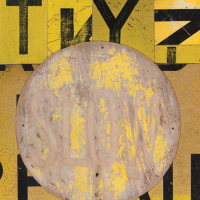49. ROSALIE GASCOIGNE Amber

You seek out the spirit of the landscape to match your own spirit.1
Rosalie Gascoignes art is a response to her environment, generated by the powers of intuitive, experiential knowledge and her search for a truth to landscape. Her artistic practice is founded on a spiritual connection and through her use of suggestion, metaphor and association. Her art is activated by the formal and evocative power of its material form.2 Gascoignes modernist strategies and uncomplicated constructions result in beautifully crafted, unique interpretations of her personal experiences of the land she releases them, opening the possibilities for them to be seen as objects of beautyformed from the shapes of experience and memories.3
Rosalie Gascoigne was born in New Zealand in 1917, and in 1943 moved from Auckland to Canberra with her astronomer husband, Ben, just before the outbreak of the second World War. She spent the majority of her adult life in Canberra where she lived and worked until her death in 1999. Over the years, the strange, unfamiliar trees and harsh light of the Monaro wheat belt became etched into her consciousness, the artist developed a profound appreciation for the beauty which surrounded her and as a result, her art presented the area in a wholly unique way. Often overlooked by artists in favour of Australias coastal beauty and Red Centre, the landscape around Canberra became a source of inspiration to Gascoigne which would infuse and inform her art over the years to come.
The artist created her work from found objects - bones, feathers, sheets of tin, soft drink crates materials that had been discarded and weathered, yet in which she found beauty. The local tips, junkyards and paddocks became hunting grounds for Gascoignes assemblage parts she would spend days driving between dumps foraging for materials which she could use. I discovered the country dump, which I had been rather prissy about before I started to use anything that looked good to me; you had to have a very selective eye.4
It was at a local dump that Gascoigne came across the first retro-reflective road signs. The present work, Amber 1992 is an assemblage of reflective road signs and plywood the materials that characterise the very best and most well-known of Gascoignes work. The artist would cut the road signs into shapes and create tessellated patterns of colour and text. Here, the title alludes to the amber traffic signal, the words SLOW faintly discernible in the middle of the central, circular plywood sign.
Rosalie Gascoigne was 57 years of age when she first exhibited her art, just four years later she was the subject of a major survey exhibition at the National Gallery of Victoria. Four years after this exhibition, she was chosen to represent Australia at the Venice Biennale, alongside Australian painter, Peter Booth (born 1940). The upwards trajectory of her career continued with many more survey shows and accolades, both in Australia and overseas. Her work is represented in each major public institution in Australia and in the world-renowned Metropolitan Museum of Art in New York City.
Footnotes
- Rosalie Gascoigne, in a conversation with Deborah Edwards, cited in Edwards, D., Rosalie Gascoigne: Material as Landscape, Art Gallery of New South Wales, Sydney, p.11
- Edwards, D., Rosalie Gascoigne: Material as Landscape, Art Gallery of New South Wales, Sydney, p.11
- ibid
- Rosalie Gascoigne, cited in Macdonald, V., Rosalie Gascoigne, Regaro, Sydney, p.28
Caroline Jones MArtAdmin